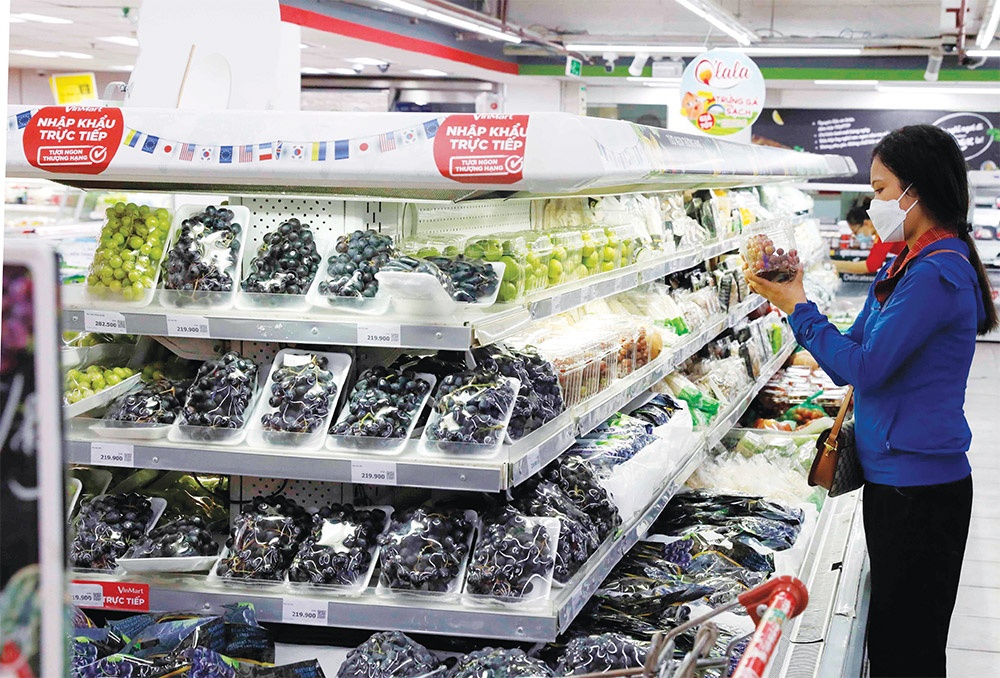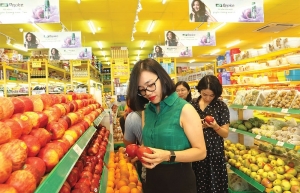Fruit imports head increasingly to the home market
 |
| North America provides grapes for Vietnam while New Zealand exports some types of berry, Photo: Le Toan |
Vietnam will be a key export market for fruit products originating from Japan, according to an event to promote imports organised by the Japan Fruit and Vegetables Export Promotion Council in collaboration with the Japan Food Product Overseas Promotion Centre in January.
Currently only apples, pears, and tangerines are officially imported from Japan to Vietnam. Japanese fruits are favoured by many Vietnamese consumers and chosen as gifts despite higher prices due to strict quality control.
Seiki Furudate, deputy consul general of Japan in Ho Chi Minh City, said, “In the ASEAN region, the income of Singaporeans is higher than that of Vietnamese people, but more Vietnamese buy Japanese fruit even though the price is quite high. Vietnam is a high potential market for Japanese fruit exporters because of its high population and great demand for safe and quality fruit products.”
In addition to pears that are out of season, apples and tangerines are two Japanese fruits currently widely sold in supermarkets and imported fruit stores in Vietnam. There are three main types of Japanese apples on the market, including fuji, kinsei yellow, and sekaiichi red.
Yuya Arashima, CEO of Star Kitchen, a Japanese fruit business at Takashimaya Trade Centre in Ho Chi Minh City, commented that Japanese fruits often have higher prices than others on the market. However, they possess perfect taste and appearance, so they are often chosen by Vietnamese consumers as gifts, especially during holidays.
“In addition to the three main fruits, we hope that grapes and strawberries will also be introduced into the Vietnamese market,” said Yuya Arashima.
Vietnam imported about $1.96 billion of fruit and vegetable products in 2023, according to data from the Vietnam Fruit and Vegetables Association. The main import markets include Australia with grapes, oranges, and cherries; New Zealand with apples, kiwis, and blueberries; North America with apples and grapes; and South Korea with pears, strawberries, and grapes.
According to the Australian Trade and Investment Commission, the total value of Australian horticultural exports to Vietnam grew 15.6 per cent to $127.4 million for the 12 months to July 2023, the end of the Australian financial year.
Vietnam is now Australia’s second-largest export market and accounted for 7 per cent of all Australian horticultural exports over this period. In comparison, the General Department of Vietnam Customs reported that horticulture exports to Australia in 2022 were worth more than $164.2 million, including fruits, vegetables, and cashew nuts.
Last December, Australia also began promoting exports of popular summer fruits including peaches and nectarines to Vietnam.
“Agricultural products and fresh fruits will continue to become a key trade promotion focus in the close diplomatic relationship between the two countries. Australia will be interested in developing fruit products here in the near future,” said trade and investment commissioner of the Australian Trade Promotion Agency in Vietnam, Chris Morley.
In the fiscal year 2022-2023, Australia’s total agricultural products exported to Vietnam hit $3.4 billion, an increase of 51.7 per cent on-year. As such, fruits and nuts accounted for 3.8 per cent of total agricultural exports to Vietnam.
Figures from New Zealand Trade and Enterprise (NZTE), food and beverages (F&B) account for 77 per cent of New Zealand’s total exports to Vietnam, with produce fruits and nuts forming 23.4 per cent of those F&B exports. New Zealand has consistently posted double-digit growth of the exports of apples and kiwi to Vietnam over the past few years.
“With consistent growth of New Zealand’s export of apples and kiwis to the Vietnamese market over the last few years. The potential for further growth of imported fruit consumption looks to continue, especially in the apple sector where considerable growth opportunities are present in Vietnam”, said Giang Nguyen, head of F&B Business Development of the NZTE.
Although it is believed to possess long-term growth potential, many foreign fruit importers and exporters assess that the market will decline slightly in 2024 due to reduced purchasing power caused by the economic recession.
Le Viet Si, CEO of imported fruit distribution business Tony Fruit, said it is forecast that imported fruit output will decrease by nearly 10 per cent compared to last year.
“Importers currently do not dare to commit to output with foreign exporters. Except for Japanese fruits, most imported fruits this year have lower prices than previous years,” Si said.
According to Le Huu Tinh, who is the senior marketing manager of Thiso Retail, the owner of the South Korean joint venture supermarket chain Emart, although some products such as gala apples are in good season due to increased shipping costs, the selling price also increases.
“Instead of bringing American apples and green grapes to Vietnam by sea, which will be delayed, affecting product quality and business seasons, importers choose air freight. Therefore, there will be less diversity, some items will have high prices,” Tinh informed.
 | Imported fruit gaining a bigger foothold in market The total import turnover of fresh fruit products grows steadily each year, making Vietnam a promising market for Australian and New Zealand businesses. |
What the stars mean:
★ Poor ★ ★ Promising ★★★ Good ★★★★ Very good ★★★★★ Exceptional
Related Contents
Latest News
More News
- Sustainability a core value for DKSH’s vision (January 07, 2026 | 16:00)
- People encouraged to contribute and grow at AstraZeneca Vietnam (January 07, 2026 | 15:48)
- Dat Bike accelerates sustainable mobility (January 07, 2026 | 15:24)
- Innovation to support modern healthcare development (January 07, 2026 | 10:00)
- Six localities record double-digit growth as regional performance diverges in 2025 (January 06, 2026 | 18:00)
- E-commerce market undergoes transformation amid rising competition and regulation (January 06, 2026 | 17:54)
- Vietnam’s industrial output hits seven-year high in 2025 (January 06, 2026 | 17:47)
- GELEX’s credit rating outlook upgraded to 'Positive' by VIS Rating (January 06, 2026 | 16:49)
- Finance sector lays firm groundwork for 2026 after major reform (January 06, 2026 | 15:30)
- Vietnam’s seafood exports surpass $11 billion in 2025 (January 06, 2026 | 08:51)

 Tag:
Tag:


















 Mobile Version
Mobile Version